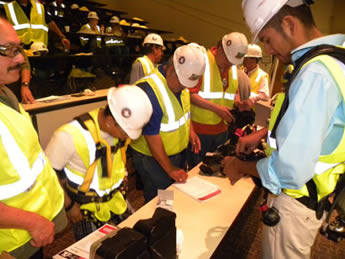Guest editorial by the Law Offices of John M. McCabe, P.A.
Those who work in the construction industry know that their jobs can be dangerous. They work with heavy equipment and at great heights. If they are not careful they run the risk of serious injury while on the job. The North Carolina Department of Labor has identified the top four hazards that construction workers in the state face. Workers should be aware of these dangers and some steps for avoiding them.
Falls
The number one risk those working in construction in North Carolina face is falling. The Occupational Safety & Health Administration has identified this as an issue for construction workers nationwide, as well. According to U.S. Bureau of Labor Statistics data, falls count for one in three construction facilities each year. The number of fatalities from falls at constructions sites has been increasing since 2003.
Workers can take steps to prevent falls. When people are working at heights greater than six feet, they should be sure to use some sort of personal fall arrest system, such as a harness or guardrails. Workers should also use safety harnesses or warning line systems when working on low-sloped roofs. When working on steep-sloped roofs, workers need safety harnesses as well as guardrails or safety netting. When workers are using scaffolding over 10 feet, they should have guardrails in addition to a fully planked work surface and toe boards.
Electrocution
Another danger that the NCDOL has identified for the state’s construction workers is electrocution. Construction workers across the U.S. run the risk of being electrocuted while working. OSHA reported that electrocution is the fourth leading cause of construction worker fatalities in the country, and an average of one worker per day dies from electrocution.
Workers can protect themselves from electrocution by installing ground fault circuit interrupters at job sites and making sure that all power tools are grounded before use. Additionally, workers should never use tools with frayed cords and should use double-insulated tools when possible. Workers should make sure that all extension cords are designed for hard or extra hard service and have grounding pins. All workers should also make sure they keep themselves and all tools away from energized power lines.
Struck-By
Construction workers can be struck by falling, swinging or flying objects at worksites if they are not careful. Working or walking below elevated worksites exposes a worker to the chance of being struck by an object. According to OSHA, about 26 percent of construction worker deaths are due to “struck-by” incidents.
Workers should always wear hard hats when on the jobsite and keep safe distances from suspended loads. Workers should barricade crane superstructures to keep others a safe distance away and make sure that all loads are secure and lifted evenly to prevent slipping. If workers are near traffic, they should wear reflective vests to increase their visibility to drivers.
Caught-In
Construction workers run the risk of being caught in trenches, heavy machinery or in between large objects while working. Approximately 16 percent of all construction worker fatalities are attributable to “caught-in” hazards, according to OSHA.
>Workers can improve the safety of the jobsite by sloping the side of trench walls or installing trench boxes, as well as using ladders in trenches over four feet deep. Workers should keep the soil pile from a trench at least two feet away from the trench. A jobsite with a trench should always have a competent trench person who knows safety protocols for working with trenches such as how to take corrective action in the event of an emergency.
Additionally, workers should avoid positioning themselves between heavy equipment and immovable objects or within the swing radius of rotating equipment. Workers should never remove or disable equipment guards, either. Read more at Digital Journal.

